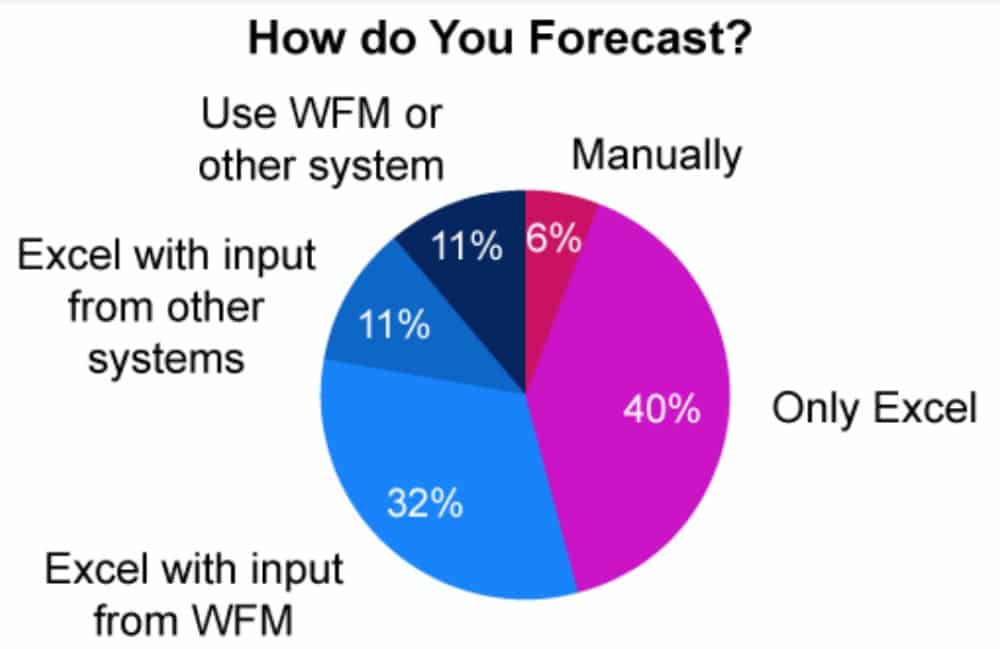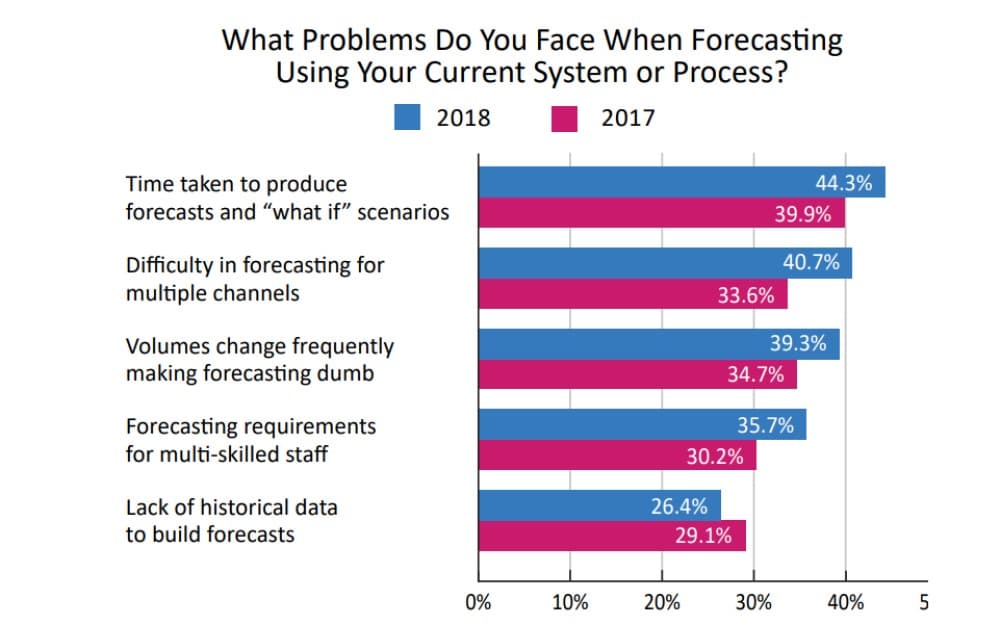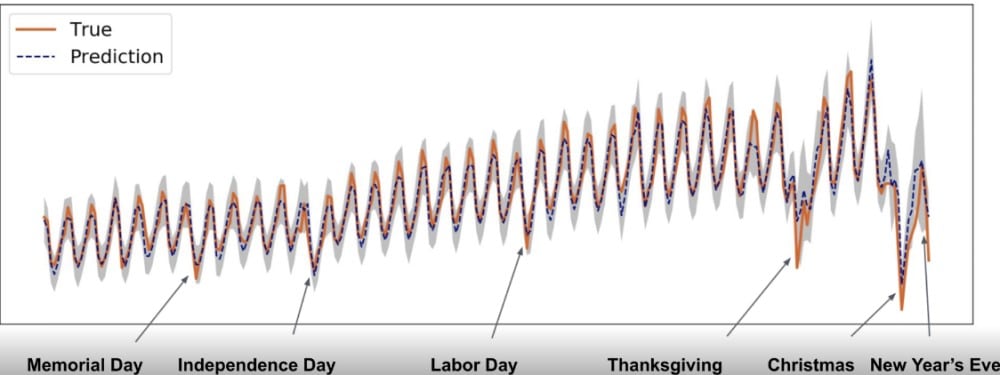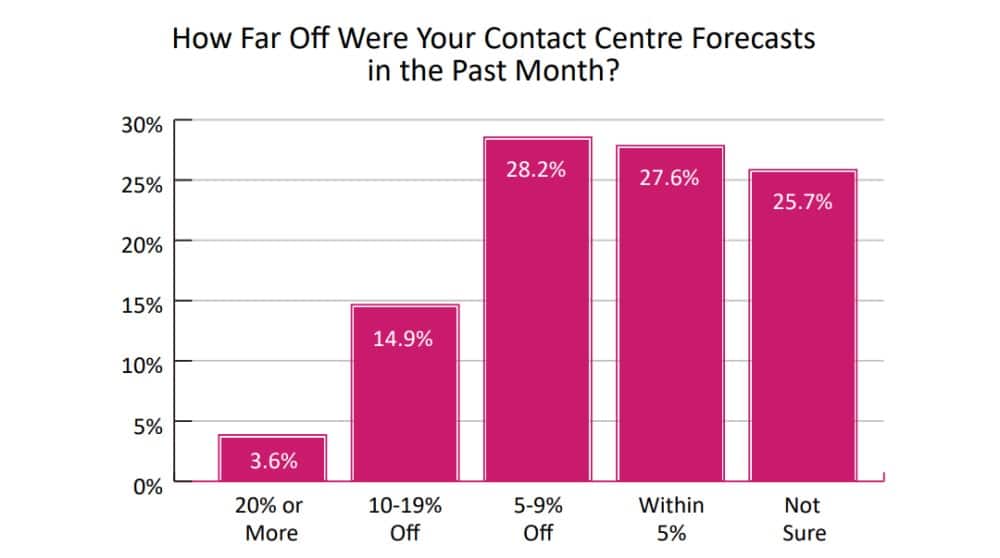A common refrain in our series on contact centres has been that they are “people businesses”. The critical element of any centre’s operations is the interaction between agents and customers. In a very real sense, a centre’s workers are the organisation’s most precious resource.
As with all valuable resources, those workers must be managed and handled effectively. There’s an entire strand of the operations of any call centre devoted to this. Forecasting and workforce management (WFM) are the two principal elements in that area.
This post is going to take a closer look at forecasting and WFM in the contact centre niche. Read on, and you’ll learn what forecasting is all about and how it helps centres tailor their workforce. We’ll also go on to discuss some of the most common forecasting techniques. As well as the vital KPIs and metrics associated with them.
What is Forecasting in the Context of Contact Centres?
Hear the word “forecasting”, and your first thought might be for the five minutes at the end of the nightly news. Just as a weather forecast is about making predictions, so too is forecasting in call centres. The only thing that changes is what’s getting predicted.
For contact centres, what managers and agents need to know is the volume of contacts to expect at any given time. To deliver a superior level of service to customers, a contact centre has to plan ahead. Forecasted contact volumes are the building blocks of effective planning.
The importance of forecasting stems from how it aids a centre to balance high-quality service and cost-efficiency. How essential forecasting is in that regard is evident once you get to grips with its connection to WFM.
Demand & Supply – The Relationship Between Forecasting & WFM
In many types of business, supply and demand is an essential concept. In retail, companies must have the right amount of stock to meet consumers’ needs. They must, though, avoid having too much inventory as that can raise their costs unnecessarily. Things are broadly similar in the call centre industry.
A contact centre supplies advice and solutions in the place of retail goods. They must meet customer demands for that assistance. The higher the demand, the higher the call volume the centre will receive.
Rather than increasing stock levels, a centre meets increased demand by having more working agents. Having too many advisors active, though, damages an organisation’s bottom line. No business wants to be paying workers who don’t have enough work to keep them busy.

Source: Call Centre Helper
FM Outsource explained how “labour flexibility” was crucial to the firm’s success. The business has both on-premises and home-based agents. They also have advisors who work core hours, but can add working time to those flexibly. Getting their forecasting right is the only way to know how to manage the workforce best.
All centres must get as good an idea as they can of the demand which their supply must satisfy. Factors that have to get considered when forecasting include:
- Historical contact volumes
- Patterns and trends of contacts over time
- Typical seasonal fluctuations
- Holidays, events, and occurrences that can impact contact volumes. These could be specific to a business, a country, or even global.
As you’ll have gathered, building accurate forecasts and robust models takes time. It’s also a process that requires a high volume of reliable data. Contact centre operators have many pulls on their time. They often struggle to give forecasting the attention it deserves. That’s at least according to a recent Call Centre Helper survey:

Source: Call Centre Helper
More than 44% of respondents reported the time taken to forecast as a major challenge in the area. Almost as many cited difficulty forecasting for multiple channels as a problem. Those hurdles – and many others – are why centres need to find smart solutions. It’s why they look to different processes and techniques to make forecasting easier.
Techniques Contact Centres Use for Forecasting & WFM
Modern software solutions let contact centres capture a lot of data. That includes details about calls and contacts via other channels. Jack and Charlotte at FM Outsource told us that they use hourly data to forecast demand. They also revealed that their centres get more complex data from their clients every week. That data, though, is no use by itself.
Centres must find the best way to use it for forecasting. There are presently three leading techniques used across the industry:
- Triple exponential smoothing (sometimes called the Holt Winters Technique)
- Auto regressive integrated moving average (ARIMA)
- Neural networks
Triple Exponential Smoothing
Exponential smoothing is a statistical technique to reach more accurate forecasts from data. You take as many data sets from previous periods (weeks, months, years, etc.) as you desire. You then use that data to predict the next period but give greater weight to the most recent data.
Take the example of call volumes. If you have data on calls for the past three weeks, an exponential smoothing formula may look like this:
NEXT WEEK’S VOLUME = ½ OF LAST WEEK’S VOLUME + ¼ OF VOLUME FROM 2 WEEKS AGO + 1/8 OF VOLUME FROM 3 WEEKS AGO
That’s a simple example, but shows the general idea of exponential smoothing. In contact centre forecasting, it’s not only contact volumes that must get accounted for. That’s where the “triple” part of triple exponential smoothing comes in.
With triple exponential forecasting, three components of the data get considered:
- Level – the pure volumes of contacts
- Trend – how volumes have increased or decreased from period to period
- Seasonality – Impact which the time of year has on volumes
All three aspects of the available data get smoothed exponentially. That helps centres get the kind of accurate forecasts they need. In general, though, this forecasting technique is better for the longer term. It’s not as useful for day-by-day predictions.
ARIMA
ARIMA has gained popularity as a forecasting method in the past decade. That’s since the Office for National Statistics (ONS), adopted it as their technique of choice in 2007. ARIMA is more complicated than triple exponential smoothing. It’s not worth getting into the nitty-gritty of the statistics here.
What’s important to note about ARIMA is how it uses historical data. ARIMA models for forecasting “explain” present data sets based on past values (i.e., from a year or more ago). Comparing data with that from prior periods smooths it out to make forecasts more accurate.
Neural Networks
As you may know, AI is having a major impact on business practices. Contact centre forecasting is no exception. Neural networks are AI-powered “machines”. They mimic the structure of neurons in the human brain. The kind of processing power that lets them wield makes them ideal for forecasting.
A neural network can process vast amounts of data from many inputs. The more data a network receives, the more accurately it can identify patterns and trends in that data. It can then develop accurate forecasts for the future.

Source: Uber
The intelligence of neural networks helps them to cope with the nuances of centre data. For example, they can recognise and account for the impacts of special days. They can also factor in marketing activity and other external inputs.
Call centre operators aren’t statistics professors. They don’t knock out some exponential smoothing over their morning coffee. Centres employ equipment to help handle their forecasting. According to a 2018 Call Centre Helper study, what they use isn’t all that advanced.
A surprising 66.4% of centres used spreadsheets for WFM, while over 10% used a pen and paper. With that lower level of technicality, operators also must consider other factors. They need to understand key performance indicators (KPIs) and metrics crucial to forecasting.
KPIs & Metrics Crucial to Forecasting & WFM
When we spoke to FM Outsource, Jack told us that the firm’s forecasting combined two elements. For the best WFM, FM Outsource focuses on “efficiency” and on “quality”. That’s an attitude typical across the niche.
Contact centres schedule staff to deliver on customer satisfaction and be as efficient as possible. To that end, there are several critical KPIs and metrics that operators track and focus upon.
- Service Level – The targeted level of service any contact centre wishes to deliver. Most often, this gets defined as the number or percentage of contacts resolved with a given time.
- Average Handling Time (AHT) – The mean time it takes to resolve the entirety of a customer contact. AHT comprises the time it takes a customer to reach you, how long gets spent solving their problem and any post-contact processing.
- Schedule Adherence – The percentage of time an agent spends working out of the total time they’re scheduled to do so. Lower adherence means an advisor is not as efficient or productive as they could be.
- Cost per Contact – How much a centre spends for each contact with a customer. Wages and operating expenses combine to account for the total cost per contact. Efficient WFM is marked out by a lower cost per contact.
- Attrition – The rate at which a centre loses employees. That may be through termination, resignation, or retirement. Attrition is a metric that’s vital to any centre’s long-term staffing. Staff lost through attrition must get replaced with new on-site or remote agents.
Forecast Accuracy – How close a centre’s predictions of contact volumes are to reality. Forecast accuracy is crucial to monitoring and improving forecasting models. Not all centres can achieve optimal levels of forecast accuracy:
Source: Call Centre Helper
Unforeseeable Circumstances – Coronavirus & Forecasting
So far, we’ve discussed forecasting in “normal” circumstances. WFM in contact centres is about making sense of data and trends within it, to predict demand. That way, operators can be as sure as possible that they can deliver the level of service they want. There are some unforeseeable circumstances, though, that blow all forecasting out of the water.
In 2020, the world is grappling with a Coronavirus crisis. The implications of the outbreak are incredibly far-reaching. Aside from the human cost and suffering, the illness will also have profound cultural and commercial impacts. Many companies will close, and consumer interaction with all brands is sure to change. Precisely how it will evolve, though, is impossible to predict. When present circumstances are unprecedented, accurate forecasting is simply impossible.
Forecasting With Accuracy – A Key Challenge for Contact Centres
Contact centres are “people businesses”. The core of centre operations comprises the interactions between customers and agents. The demand of customers for the support a centre provides can fluctuate. Operators must ensure their “supply” of advisors is flexible to account for fluctuations.
Scheduling and hiring agents to meet demand is called workforce management (WFM). The only way to achieve effective WFM is with accurate forecasting of contact volume. That’s why such forecasting is so crucial.
Call centres use a variety of techniques for forecasting. Those techniques use varied data to make complex predictions. Contact centres focus on efficiency, quality, and other KPIs. That’s how they track and manage their forecasting.
Originally published Jun 26, 2020, updated Jan 17, 2023
